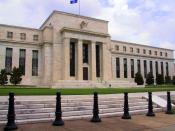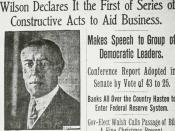Introduction The American economy has many components which contribute to its growth and which affect its rate of inflation, but the overriding stimuli stem from the monetary and fiscal controls imposed by the Federal Reserve and government, respectively. The economy has enjoyed modest growth for several years, and that can be expected to continue. The Federal Reserve is likely to raise interest rates in late 1999 or early 2000 in order to keep the rate of inflation down; this research considers the reasons that this is likely.
Analysis The Federal Reserve sets interest rates by mandating the rates at which Federal Reserve banks loan funds to other institutions. These rates then affect the rates of those institutions as they seek to maintain their profit. Thus an increase in rates by the Federal Reserve results in an increase in interest rates charged to customers by financial institutions throughout the nation. Investors may, in this instance, move some funds out of other investments in order to take advantage of the higher rates (such as moving out of bonds), and the stock market may see a decrease in value as investors weigh the effect of the interest rate increase on corporate borrowing.
The Fed held interest rates steady for most of 1997 and 1998 during which time the economy moved forward at a slow pace. Inflation was kept in check, the federal deficit declined, and unemployment was at near-record lows throughout the country. Despite this, there was little upward pressure on wages and, in general, consumers have seen some slight interest in their purchasing power. By late 1998, there was an increase in wages in some service industries and among computer and technical professionals; this has led to some increase in service prices.
Consumer spending as measured through retail sales generally increased throughout...


![English: United States mean duration of unemployment 1948-2010. Data source: FRED, Federal Reserve Economic Data, Federal Reserve Bank of St. Louis: Average (Mean) Duration of Unemployment [UEMPMEAN] ; U.S. Department of Labor: Bureau of Labor Statistics;](https://s.writework.com/uploads/3/35750/english-united-states-mean-duration-unemployment-1948-2010-d-thumb.jpg)